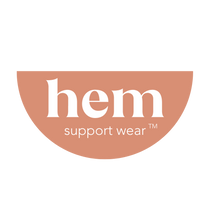Pelvic Organ Prolapse and Periods
Managing Prolapse and Periods: A Guide
If you’ve been diagnosed with or suspect you have POP (Pelvic Organ Prolapse), you may be wondering how to manage your period safely and comfortably. You may have questions about whether you can use the same period care methods you’ve used in the past, or if your methods need some updating. This is totally normal and completely valid, and we’re here to help with managing prolapse and periods!
Are my POP symptoms getting worse around my period?
As your hormones change throughout your cycle, you may notice that your prolapse symptoms change, too. It’s not just you, either – this is something that many people with prolapse experience! Some people report that their symptoms worsen as their period approaches and for the first few days of their cycle, as well as around ovulation. This makes complete biological sense; estrogen levels drop during these phases, which leads to muscle fatigue and weakness throughout your body, including your pelvic floor. If you’re wondering whether prolapse is worse when on your period, this could be why.
Can I wear a menstrual cup with POP?
Menstrual cups are a sustainable, and for some people, a convenient option for period management. They are becoming more popular, and for good reason: they’re more cost-effective, produce less waste, and can be worn for longer amounts of time compared to other forms of period care. Some people with prolapse find them to be comfortable, while others do not. It may take some trial and error to find a cup that’s comfortable and works for you, but there are lots of options available and resources to help you find the right size. Some people with prolapse find that cups designed for a low cervix or are short and wide are the most comfortable to use. Finding the best menstrual cup for pelvic organ prolapse can make a significant difference.
As with all topics surrounding prolapse, the use of menstrual cups by people with POP has not been widely studied. And while there have been claims that menstrual cups can cause prolapse, this is not supported by conclusive evidence. Some healthcare providers, however, have cautioned that improper use of menstrual cups can make prolapse symptoms worse. This is due to the suction that menstrual cups create within your vaginal canal and its effect on your pelvic floor muscles, so it’s very important to use – and remove – your cup correctly.
One of the most common errors that people make is to try to remove it by pulling on the tab. Doing this only enhances the suction and can make POP symptoms worse. To properly remove the cup, start by relaxing your pelvic floor muscles. You can then “break the seal,” or release the suction, by collapsing the cup and allowing air to flow in your vagina. To do so, “pinch the base of the menstrual cup or put one finger up the side of the cup and listen for the sound of air, meaning the seal has been broken,” say the makers of Pixie Cup. Then, you can squeeze the cup and gently pull or wiggle it out. Proper usage is essential to avoid issues with menstrual cups and prolapse.
Are tampons safe to use with POP?
For some people, a tampon that won’t stay in can be an initial symptom of prolapse, notes POPup, an evidence-based support and resource hub for people managing POP. Whether you are able to wear a tampon will depend on your symptoms, the severity of your prolapse, and if it is comfortable for you to wear one. If you have mild prolapse, you may find tampons comfortable. (For some people, switching to a shorter and wider size provides a better fit, just like with menstrual cups.) If your cervix has fallen into your vagina, you may not be able to wear a tampon. It’s important to remember that tampons should only be used during your period – NOT as a treatment for POP or incontinence – and should be changed regularly to reduce the risk of toxic shock syndrome. If you find your prolapse worse during your period, you might need to reconsider using tampons.
No matter what you use to manage your period, it’s important that you discuss your options with your healthcare provider. Together, you can make an informed decision about the best ways to care for yourself and your body throughout your cycle. Whether you choose a menstrual cup or another method, your comfort and health are paramount.


